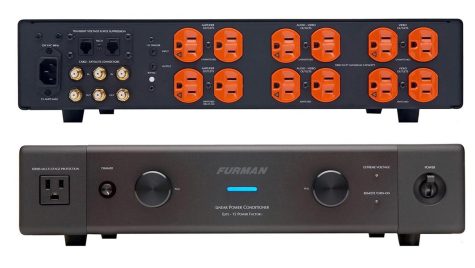
Best Home Theatre Power Managers (Complete Guide)
Are you looking to take your Home Theatre Power Managers experience to the next level? Having the right power manager can make all the difference. With this complete guide, you will be able to find the best home theatre power managers tailored to meet your needs and budget. We’ll cover what power managers do, their features, and reviews of some of the top products on the market today. Whether you are just getting started or a veteran in a home theatre setup, this guide will have something for everyone.
Home Theatre Power Managers
Home Theatre Power Managers are an essential part of any home entertainment system. They offer a range of benefits that make them a must-have for anyone who wants to get the most out of their home theatre. These devices help to protect your expensive equipment from power surges, spikes, and other electrical disturbances. They also provide enhanced safety by preventing overheating and short circuits that could lead to fires or other dangerous situations.
Additionally, some models come with automatic voltage regulation (AVR) which ensures that your equipment always gets the right amount of electricity, regardless of fluctuations in the mains supply. This means that you can enjoy smooth and uninterrupted playback without any hiccups or interruptions caused by power problems.
Finally, home theatre power managers are easy to install and use. Most units come with clear instructions on how to set up and operate them, making it simple even for those who are not technically inclined. With all these benefits and more, we highly recommend getting a home theatre power manager if you haven’t already done so!
What is a Home Theatre Power Manager?
In simple terms, a Home Theatre Power Manager is an electronic device that helps manage and protect your home theatre system. It performs the crucial task of regulating the power supply to your entertainment system and ensures that it does not suffer any electrical damage due to surges or dips in voltage. The primary function of a Home Theatre Power Manager is to offer surge protection for all the devices connected to it.
Apart from regulating power supply, some advanced models also come with additional features such as automatic voltage regulation, noise filtration, and battery backup. These added functionalities ensure that your home theatre system runs smoothly without any interruptions or damages caused by power fluctuations.
It is important to note that investing in a high-quality Home Theatre Power Manager will not only safeguard your expensive entertainment equipment but also extend its lifespan. With so many options available today, choosing the right one can be overwhelming. Hence it’s essential to research thoroughly before making a purchase decision.
Benefits of Using a Home Theatre Power Manager
A home theatre power manager is a practical device that can help you keep your electronics safe and extend their lifespan. It serves as the central hub for all your home theatre components, ensuring that they receive consistent power supply and protection from voltage spikes, surges, and other electrical disturbances. One of the primary benefits of using a home theatre power manager is that it helps prevent damage to your expensive equipment caused by sudden power outages or fluctuations in voltage.
Another advantage of using a home theatre power manager is that it can help lower your energy bills. Power managers are designed to conserve energy by automatically turning off any connected devices when they’re not in use. This feature makes them an excellent investment for those who want to reduce their carbon footprint while also saving money on their electricity bill.
Furthermore, using a home theatre power manager can simplify your setup process and make it easier to control multiple devices at once. With one centralized hub for all your electronics, you won’t have to worry about switching between different remotes or outlets every time you want to watch something on TV or listen to music. Overall, investing in a reliable home theatre power manager will not only protect your valuable equipment but also provide convenience and energy efficiency benefits.
Types of Home Theatre Power Managers
- Basic Power Strip: Basic power strip is a simple way to control your devices and protect them from electrical surges. It comes with multiple outlets that can be used to plug in all of your devices, including televisions, soundbars, gaming consoles, etc. They are less expensive compared to other types of home theatre power managers.
- Voltage Regulator: A voltage regulator protects your home theatre system from power surges and spikes. It provides constant voltage output even when the input voltage fluctuates or drops below normal levels. Voltage regulators are a bit more expensive than basic power strips but offer better protection against electrical issues.
- Uninterruptible Power Supply (UPS): An uninterruptible power supply (UPS) is an advanced type of home theatre power manager that provides battery backup in case of a power outage or surge. It not only protects your equipment but also prevents data loss and damage caused by sudden shutdowns during a blackout or brownout situation.
Overall, choosing the right type of home theatre power manager depends on individual needs and budget constraints. Basic models are ideal for those who want basic protection at an affordable price point while advanced models like UPS provide comprehensive protection against all possible threats for serious audiophiles and tech enthusiasts who demand high-performance audio-visual systems for their homes.
Installation Tips for Home Theatre Power Managers
When it comes to setting up a home theatre system, ensuring that all components are receiving adequate power is crucial. This is where a home theatre power manager comes in handy. However, installing one can be a little tricky, so here are some tips to make it easier.
Firstly, ensure that the power manager is compatible with your home theatre components and has enough outlets for everything you need to plug in. Next, locate an easily accessible power outlet within close proximity of your home theatre setup. It’s important to avoid using extension cords or power strips with the power manager as they can cause voltage drops and damage your equipment.
Once you have identified the ideal location for the power manager, switch off all connected devices before plugging them into the unit. Finally, turn on the master device (usually the TV) first before powering on any other devices connected to the system. Following these steps will help ensure that your home theatre system runs smoothly and efficiently while protecting against unexpected electrical surges or outages.
How to Choose the Best Home Theatre Power Manager
A home theatre power manager is an essential component when it comes to maintaining the lifespan and performance of your electronic devices. This guide will help you choose the best home theatre power manager that suits your needs. Firstly, consider the number of outlets needed for your devices. If you have a large entertainment system, then select a model with multiple outlets to accommodate all devices.
Secondly, look for a power manager that has surge protection features as it ensures protection against voltage spikes or surges. Thirdly, opt for models with built-in automatic voltage regulation (AVR) capability which stabilizes fluctuations in electricity supply and offers stable voltage output.
Lastly, consider purchasing a model that can be remotely controlled and programmed through an app on your smartphone or tablet. This feature offers convenience and flexibility when managing your home theatre components while also saving energy by turning off idle electronics automatically. By following these tips, you can enhance the performance of your home theater system while protecting it from electrical damage caused by power outages or surges.
Conclusion: Get the Right Solution
In conclusion, getting the right solution for your home theater power management needs is crucial to ensure optimal performance and safety. With the wide range of options available in the market today, it can be overwhelming to choose the best one. It’s important to consider factors such as the number of outlets, surge protection capabilities, energy-saving features, and compatibility with your devices.
One way to get the right solution is by doing thorough research before making a purchase. Read reviews from other users and check product specifications carefully to ensure that it meets your requirements. Another way is by seeking advice from experts or professionals in the field who can provide valuable insights on which products are most suitable for your specific needs.
Ultimately, investing in a quality home theater power manager not only protects your valuable equipment but also enhances your overall viewing experience. So take the time to find the right solution and enjoy the seamless performance and peace of mind knowing that your equipment is protected.
FAQs…
What are the benefits of using a home theater power manager?
Using a home theater power manager can help protect your home theater system from power surges, voltage fluctuations, and other electrical problems that can damage your equipment. It can also help save energy by allowing you to turn off all the devices in your system at once, rather than having to turn them off individually.
Q: How do I choose a home theater power manager?
A: When choosing a home theater power manager, look for one that provides enough outlets to accommodate all the devices in your system. It should also have surge protection and voltage regulation features to help protect your equipment. Some models may also offer additional features, such as programmable outlets or remote control.
Q: How do I install a home theater power manager?
A: Installing a home theater power manager is typically straightforward. Simply plug your home theater devices into the outlets on the power manager, then plug the power manager into a wall outlet. Some models may also require you to connect a phone line or network cable to enable remote control or other advanced features.
Q: Can a home theater power manager help improve audio or video quality?
A: While a home theater power manager can help protect your equipment and save energy, it is unlikely to have a direct impact on audio or video quality. However, if voltage fluctuations or other electrical issues were causing problems with your equipment, using a power manager could potentially help resolve those issues and improve overall performance.











